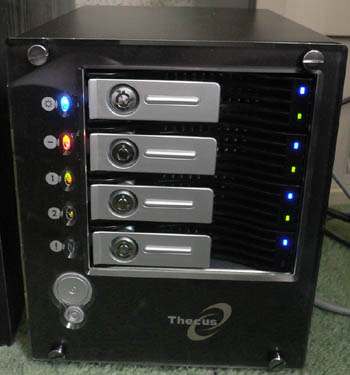Performance and Conclusion
Using the N4100 has been pleasant, with no hitches. I have, for example, ripped a DVD to the N4100 and played it back without any stuttering. Connecting to the N4100 is easy enough. Map a network drive to one of the folders on the device, put in your username and password and you're away, using it like you would any other drive.
It's hard for me to provide any particularly scientific benchmark results, given that I have nothing to compare the N4100 against, however what I can do is give you a few figures and my general opinion following some time using this device.
Using the same IOMeter throughput test I used in my XFX Revo 64 article, sustained reads were recorded as 10.15MB/s and writes as 8.42MB/s. During this time I kept an eye on the CPU usage on the N4100's status page. It was fluctuating between 50% and nearly 100%, so the device seems to be processing as best it can. 10MB/s however, isn't all that fast. It doesn't begin to saturate the 1Gbps network interface of the N4100. Concerned that this was just related to the overhead required in managing a RAID 5 array, I reconfigured the system into a four disk RAID 0 setup. Running the tests again I got 11.48MB/s reads and 13.07MB/s writes. An increase for sure, but not enough to warrant losing the redundancy provided by RAID 5.
Putting the N4100 through a more 'real world' scenario, I backed up 10.3GB of files using NTBackup onto it. This took 43 minutes 32 seconds, or an average of 4MB/s. Numerous very small files were being dealt with during the operation, which results in a general slowdown of the backup process regardless of the media being used. Continuing the unscientific research I performed the very same backup operating, but to a local disk. This operation took 22 minutes 34 seconds giving an average data rate of 7.8MB/s. Looking at it in these terms, backup operations, using NTBackup at least, aren't really all that slower over the network to the N4100 than doing it to a locally attached disk. Given the N4100 is intended as a storage/backup solution, I think we can say it would do a reasonable job of it.
Faking a disk failure while the system was running, I pulled one of the drives from the the N4100. The activity LED for that drive turned to a flashing red light and a few seconds later I was met with a wonderfully distracting buzzer, remembering that I had previously activated the buzzer warning through the webdisk interface. Fortunately, the buzzer stops after about a minute, once everybody in the office has had a chance to wonder over and find out what's going on. Running IOMeter again, I found that write speeds remained virtually unchanged, with read speeds dropping to roughly the same as write speeds. The system remained completely available, as you'd expect.
Plugging the 'failed drive' back in, the N4100 started the drive up and within seconds began the reconstruction process required to make the array healthy again. As with creating an array, you can expect to wait 7-8 hours for this RAID 5 array to rebuild. However, unlike when creating a RAID 5 array, the N4100 can be used as normal. For those of you fascinated by lights, here's a picture of the N4100 during the rebuild. Notice the power and activity lights of each drive, along with the system power light, the red busy light and the green network activity light as I login to check the status of the rebuild.
Final Thoughts
The concept of IP based storage is rapidly winning me over. The idea of having a device sat on the network, constantly available for any other machine to access or backup data is appealing to me as somebody with a lot of data to look after and a lot of media that could do to be stored centrally instead of on DVD. Similarly, that appeal can extend into the office environment as a means of both backup and data sharing. NAS is by no means a solution for the average home, however, and should stick to offices and the abodes of geeks.
Physically, the Thecus N4100 is spot on. It's small, it looks good, it has lots of pretty lights and it has adequate cooling. The drive caddies are sturdy, meaning you can remove and reinsert them without fear of them snapping, unlike some of the cheaper drive caddies I've come across in the past.
Feature-wise, the N4100 has some good stuff going for it. Active Directory support will be welcomed by net admins, otherwise the 'regular' user/groups system provides ample control over access to the device. The choice of options for RAID arrays is good. Although anybody serious about backups won't do so to a RAID 0 array, at least there's a choice there. I can't see much point in using anything other than RAID 5, when you weigh up the benefits of it against the other RAID modes available with the N4100.
What proves to be a bit of a letdown is the time it takes to create or rebuild a RAID 5 array, along with the data throughput performance. I had hoped for a fast array initialisation option, but there wasn't one. Throughput could have been better, given the disk subsystem and network interface in place, but it seems the operating system and processor limit it somewhat. Nevertheless I could stream media from it without a problem and backup to it in an acceptable time.
The last thing to consider is cost. One of these devices, with four 300GB disks included, will set you back something in the region of £1000. You have to ask yourself whether the convenience and reliability of such a solution is worth that much, or whether you're better off with a single, large external USB2.0/IEEE1394 hard drive, or perhaps bunging a couple more hard drives in your computer/backup server.
If you're looking for a new means of storing and protecting the vast amount of data you have somehow managed to acquire, then ask yourself whether an IP storage solution would be feasible for you. If you really need a 100% uptime, network attached storage device with access control and hotswap array rebuilds, and you don't mind the 7 hour RAID 5 build (which is only likely to be an issue once,) then the N4100 is worth considering. Just bear in mind that 900GB of protected network attached storage in a sexy black box will set you back a grand.















